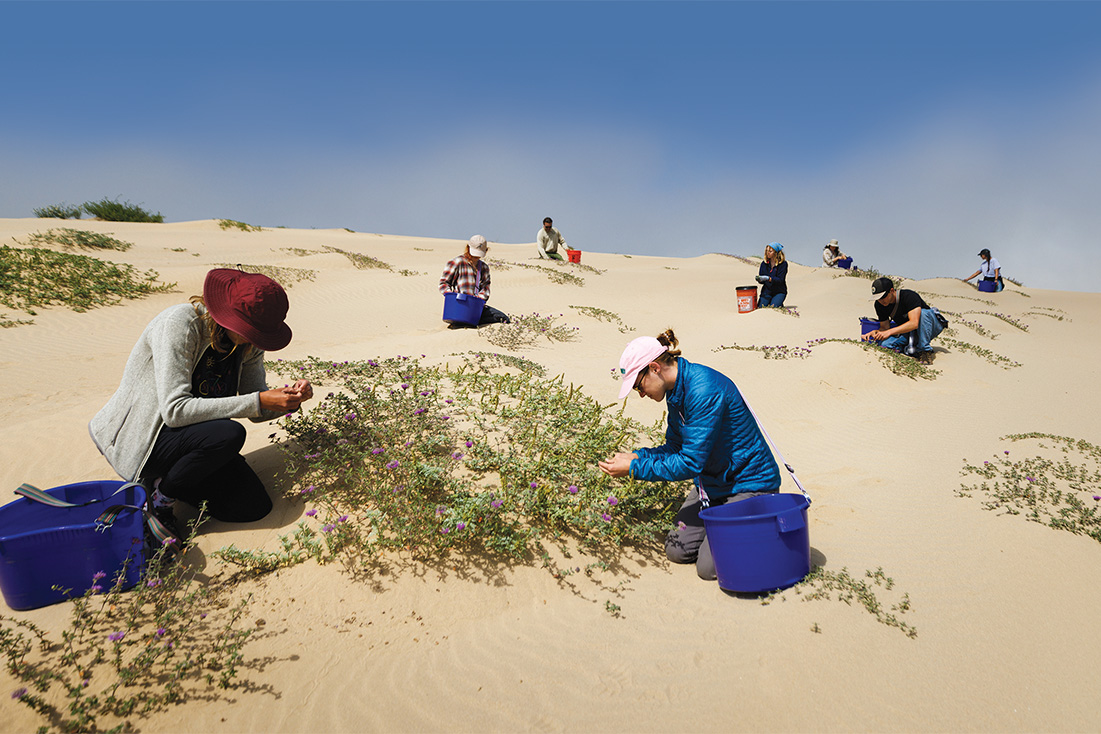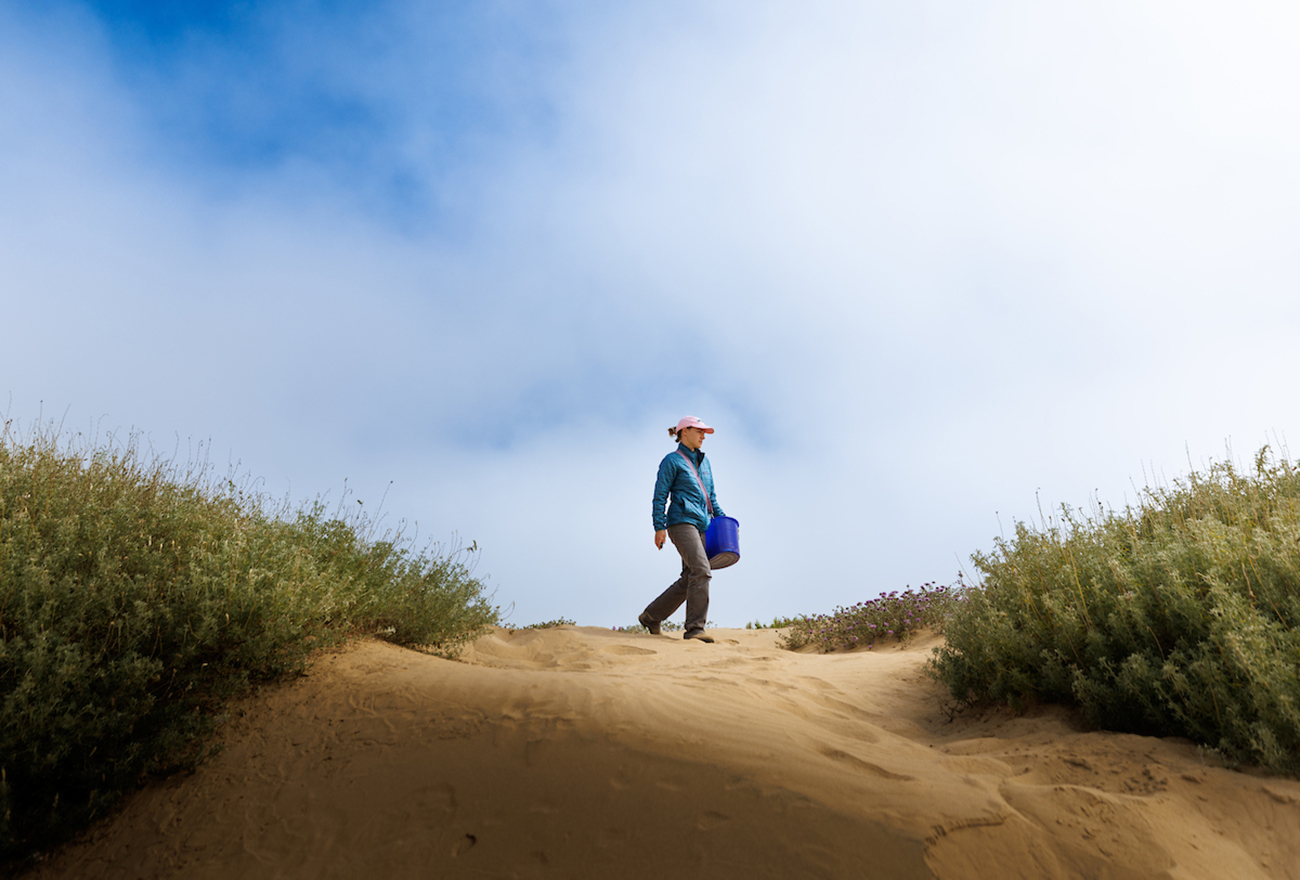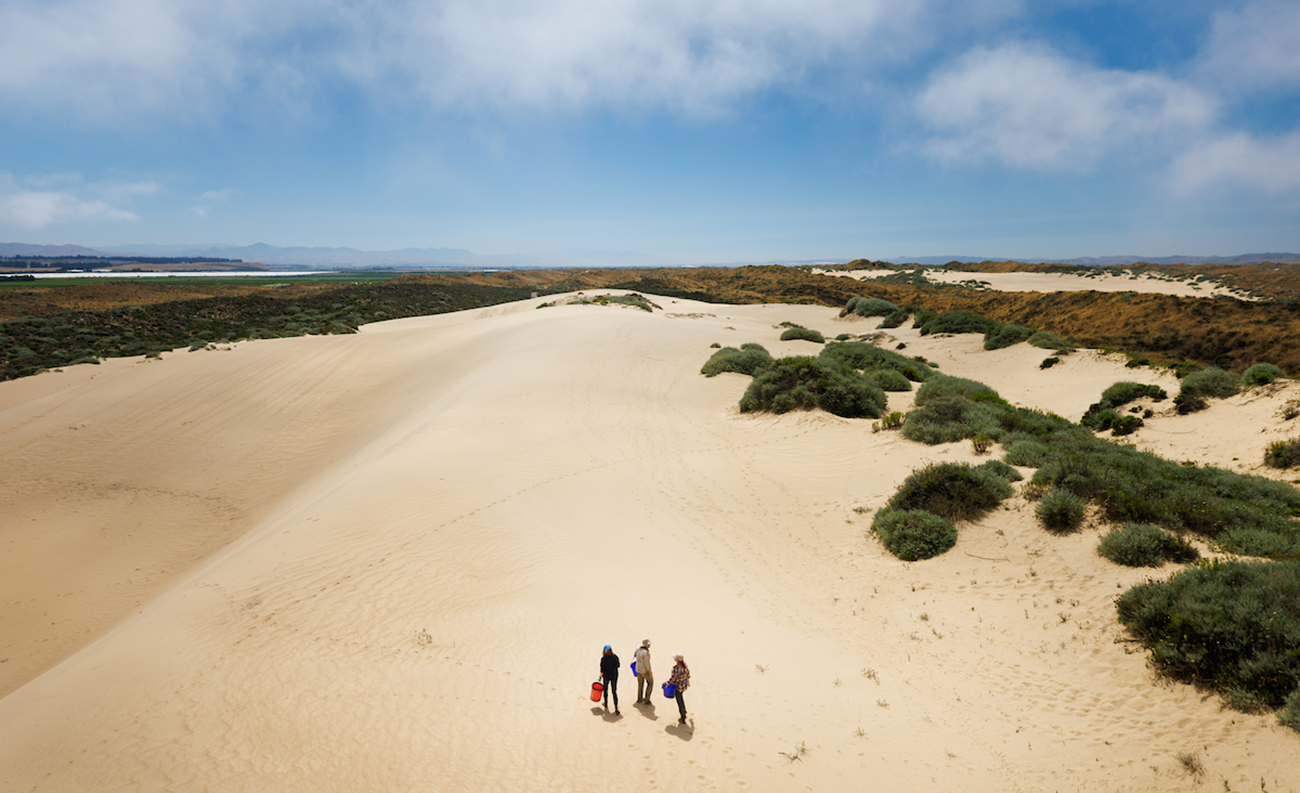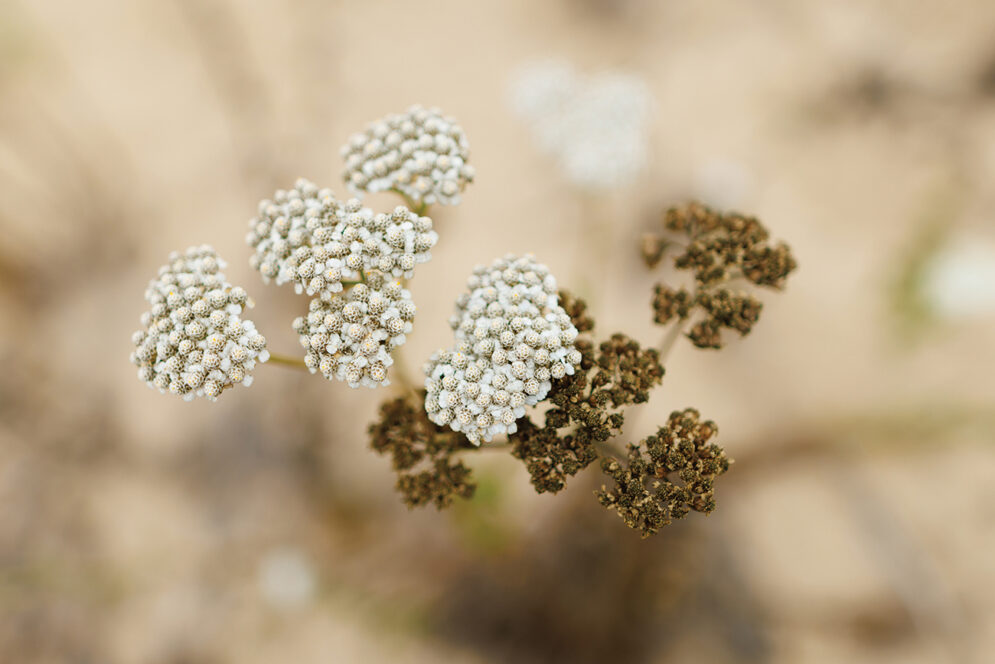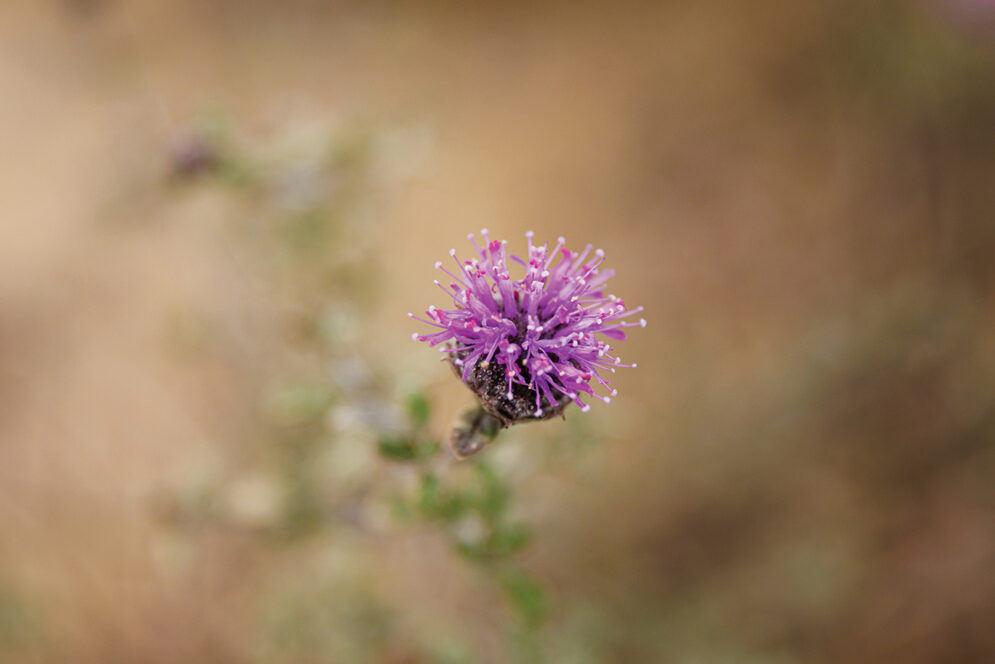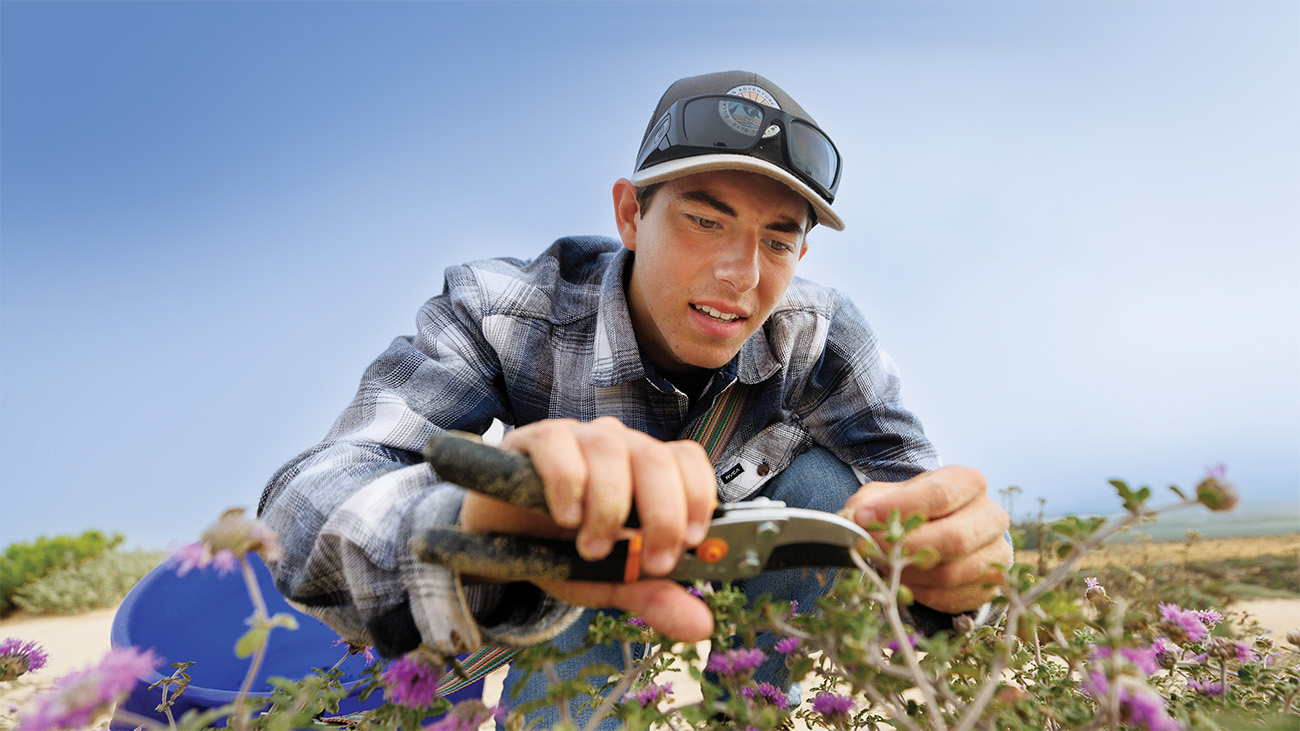
At the southern end of San Luis Obispo County, about a half-hourʼs drive from the rolling golden hills surrounding Cal Poly, lies a different world.
Massive sand dunes — like something out of an adventure movie, many of which have been filmed there — rise from the earth, dotted with shrubs and other plants. Birds wheel overhead and recreational vehicles buzz over the landscape.
For centuries, the Oceano Dunes have been special to a diverse spectrum of people. For the Chumash people, the eccentric Dunites of the 1920s, Hollywood film crews, environmentalists, recreational riders and others, this land holds a magnetic draw.
It also holds a potentially fatal flaw.
The dust that blows off the Oceano Dunes contains particulate matter smaller than 10 microns in diameter, small enough to lodge in the lungs of residents living in nearby communities and cause asthma and other medical conditions. It can be life-threatening.
For years, scientists at California State Parks have worked to mitigate the dust’s damage. One of their strategies is planting native species to stabilize the dunes and capture sand, which helps cut down on the amount of blowing dust. And for the past five years, Cal Poly students have joined those scientists out on the famous dunes.
“This is true ecological restoration,” said Ronnie Glick, senior environmental scientist with California State Parks, who has worked at the Oceano Dunes since 2006. “We are restoring some very important ecosystems and doing work to restore the ecological function of these dunes that has been lost over years of use.”
Don’t see the video above? Watch it on YouTube.
OUT IN THE DUNES
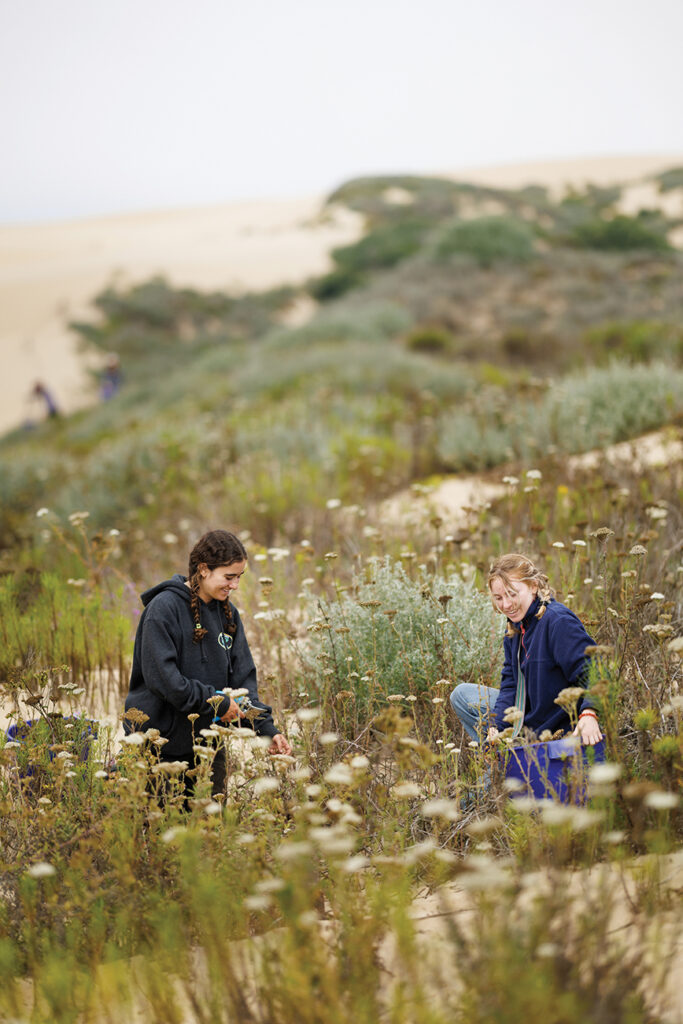
Student leads Lida Hamidi and Ella Van Hamersveld talk as they harvest plants during restoration work at the Oceano Dunes.
For a few weeks in the summer, a group of Cal Poly students join State Parks employees out at the Oceano Dunes, equipped with giant plastic buckets, pruning shears, gloves and hats. They spend time working in different vegetation “islands” in the sand, snipping the dried seedheads of different native plants.
On one July day, the group treks up a steep, sugar-white dune to get to a few patches of dune mint, one of the species they harvest seeds from. It’s peaceful out here, with the sun fighting through the marine layer to sparkle on Oso Flaco Lake, visible in the distance. The sharp scent of mint occasionally wafts through the air as the team works.
“This is truly my favorite place to be,” says third-year Molly Waddington, as she kneels down to snip off a dried brown flower. Waddington, a biology student, also took field botany and plant ecology courses last spring and learned about plant life in the dunes during those classes. “Being able to do something and take some action to help the community brightens my mood.”
Alex Velazquez, an environmental scientist with State Parks, is one of the workers guiding the students as they harvest.
“It’s refreshing to see how excited the students are about restoration and ways they can help the planet and create a better environment,” he said. “I love that they get to come out and see behind the scenes of these huge efforts.”
Use the left and right arrows on the images below to move through a gallery of plants native to the dunes
The harvesting takes place in plant communities that established in the dunes on their own, Velazquez said. Glick, the State Parks head, estimates that the team restores between 40 and 50 acres a year, or between 150 and 200 acres since the Cal Poly collaboration began in summer 2018.
On her first day in the field, student lead Lida Hamidi steps out of a State Parks vehicle, looks around, takes a deep breath and smiles. “It’s so nice to be back at the dunes again,” she says.
This is Hamidi’s second summer out at the dunes, but it won’t be her last. The recent graduate is wrapping up her student work on the project before moving to the State Parks team full time in the fall. For Hamidi, the importance of this project is in addressing issues of environmental justice.
“I love this restoration project because it addresses the airborne particles that affect people inland of the Oceano Dunes, and I think these projects are crucial to creating a sustainable future. But on top of that, I love getting my hands dirty, working with the soil and plants and sowing the seeds,” Hamidi said. “It’s really awesome to see the progress of all the work that we’re doing here, because we get to watch the plants grow as the season continues, plant them and send them off.”
IN THE GREENHOUSE
Once the seeds are harvested, a portion is taken back to the greenhouses at Cal Poly, where students will be responsible for growing about 60,000 plants. Another portion goes back to State Parks greenhouses for propagation, where workers will grow another 60,000 plants.
After a few months of growing, the plants are transported back to the dunes for replanting in designated areas. The majority of the seeds harvested — around 500 pounds each year — are combined into a mix and scattered through these areas, providing a seed bank within the project site so new plants can continue to germinate. (Restoration areas are determined by the Scientific Advisory Group, a team of scientists who work with Oceano Dunes stakeholders to determine evidence-based solutions to the dust issue.)
Because all of the plants are uniquely adapted to the Oceano Dunes ecosystem, sometimes special care has to be taken to ensure the seeds have the best shot at germinating in the Cal Poly greenhouses. For example, students have to “scarify,” or rub, the silver dune lupine seeds with sandpaper to simulate being blasted by wind and sand. Depending on each plants’ needs, the team might also take them into a mist chamber or a high-humidity area to mimic their natural environment and encourage the plants to grow.
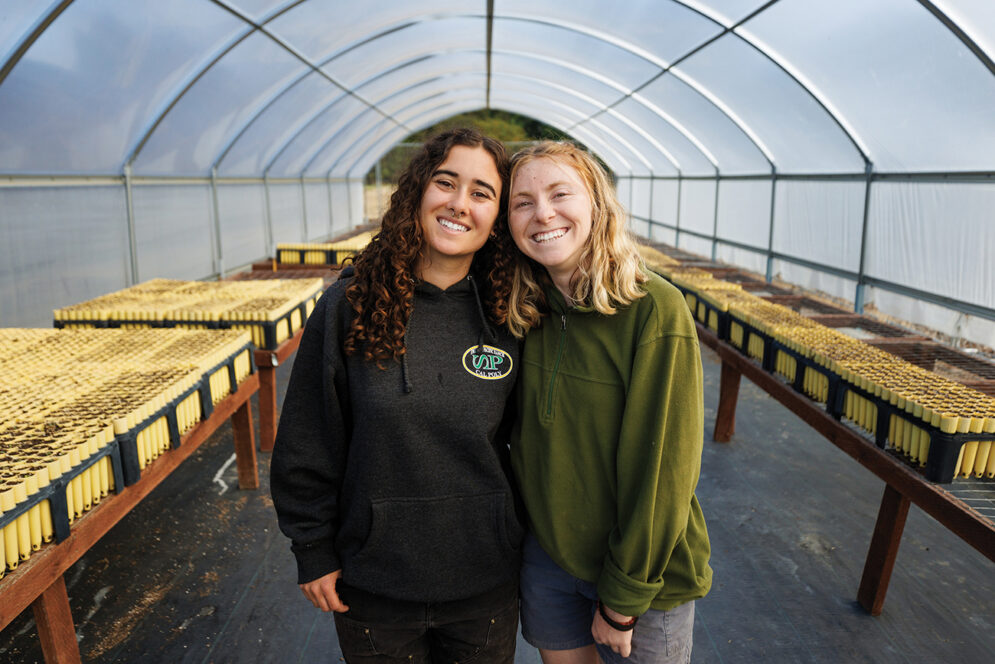
Student leads Lida Hamidi and Ella Van Hamersveld in one of the Cal Poly greenhouses where they are propagating plants.
“The most important part for us to do is to make sure that these plants get established, that they’re solid, that they’re robust enough to handle being planted in the dunes,” said Scott Steinmaus, head of the Plant Sciences Department, who co-leads Cal Poly’s work on the project. This part of the work requires students to get their hands dirty — literally.
One hot summer morning, the students shovel piles of dirt into black plastic bandpot flats, into which the just-harvested seeds will be sown. They spread the dirt down, patting it flat. It’s the most efficient way to fill the flats and prep them for planting. A dry-erase board in a classroom adjacent to the greenhouses shows the different species the students are propagating this year — 13 total.
The bandpot flats aren’t very deep — perfect for species that create a shallow yet intricate network of “fog net” roots that take advantage of fog drip from the marine layer that hugs the dunes most mornings. The only species that won’t go into the flats are the silver dune lupine, which are individually planted in conical plastic containers called supercells due to their long taproots, which dive deep below the dunes to reach water.
Use the left and right arrows on the images below to move through a gallery of plants native to the dunes
“It’s funny how much we have to baby them,” said Ella Van Hamersveld, a fifth-year biological sciences major and student lead on the project, as she and Hamidi walk through a greenhouse and check on the suffrutescent wallflower seedlings that have been growing for a few weeks.
Hamidi, her co-lead, nods in agreement.
“It’s amazing that they can grow without any help in the sand,” she said.
The students and Mike Bush, Cal Poly’s co-lead and former plant sciences lecturer, diligently water the seeds and tend to them until they grow into plants that can be transplanted to a wild environment.
“Plants don’t know when the weekend is, or when it’s finals,” Bush said, of the necessity of consistent watering and other tasks. “We have to be able to give them what they need when they need it.”
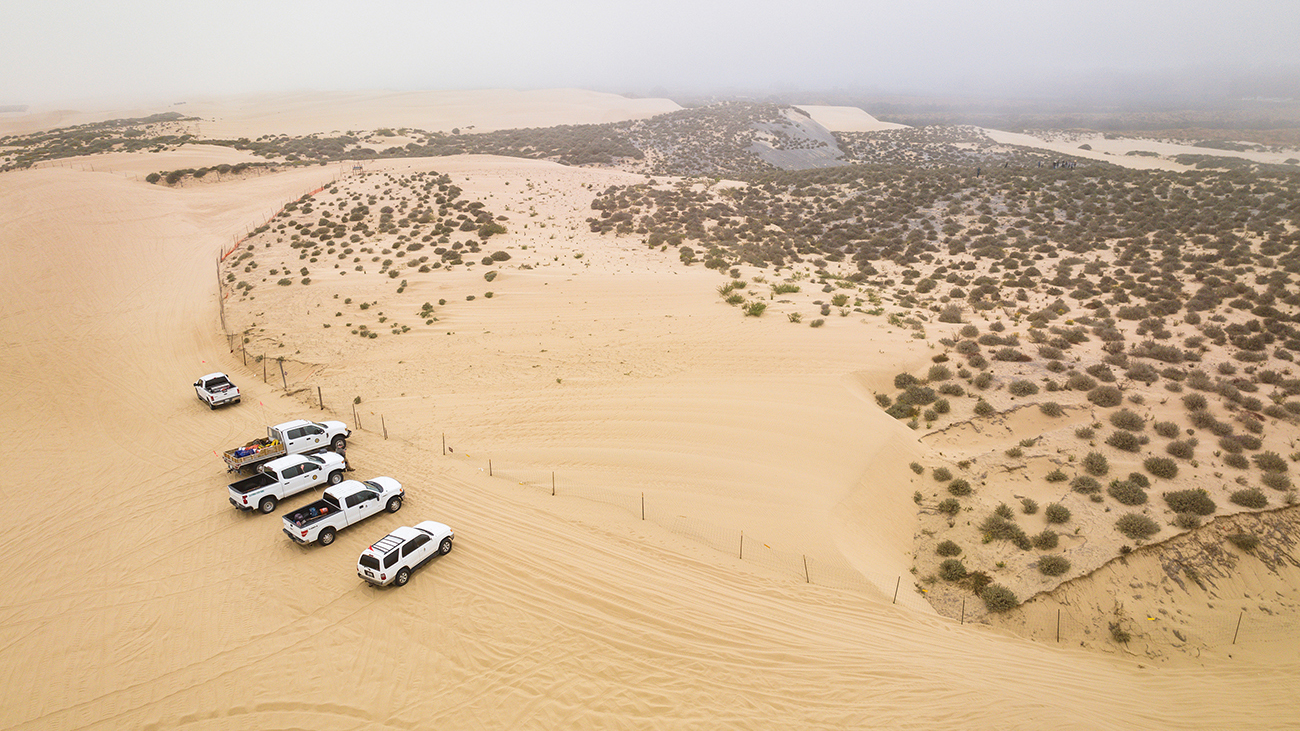
ʻLEARN BY DOING ON A BIG SCALE’
Ben Wagner, a senior environmental scientist specialist with State Parks, cautiously guides his truck down a sand dune, following a caravan of state vehicles carrying the students and State Parks scientists. It is one of the last times the Cal Poly students will be out at the dunes this summer.
Though the team has plans to harvest at a vegetation island within the State Vehicular Recreation Area (SVRA), they first stop to look at a section that has already been restored. This 20-acre site was planted in January of 2022. Already, the plants appear strong and healthy.
The area is attracting wildlife too, according to Velazquez, who tells the students that he found a burrowing owl den on this site last season. “Not even two years after planting, small animals are moving in and creating a lot of habitat,” he said.
I feel like this is an opportunity I wouldn’t get anywhere else. Being able to have that firsthand experience here is really unique, and I’m proud that Cal Poly is part of this.
The group walks through the site until they get to an outlook, where Wagner and Bush talk about the results of restoration work, and how it positively impacts the environment as an ATV distantly buzzes by.
On the way back to the trucks, Bush stops to point out a set of animal tracks: just barely visible traces in the sand. Wagner estimates that the tracks could be from a kangaroo rat. The team piles back into the vehicles to head to a vegetation island for harvesting. Today it’s yarrow, and this area has a lot of it.
It’s all ready for picking, too: nice and dry.
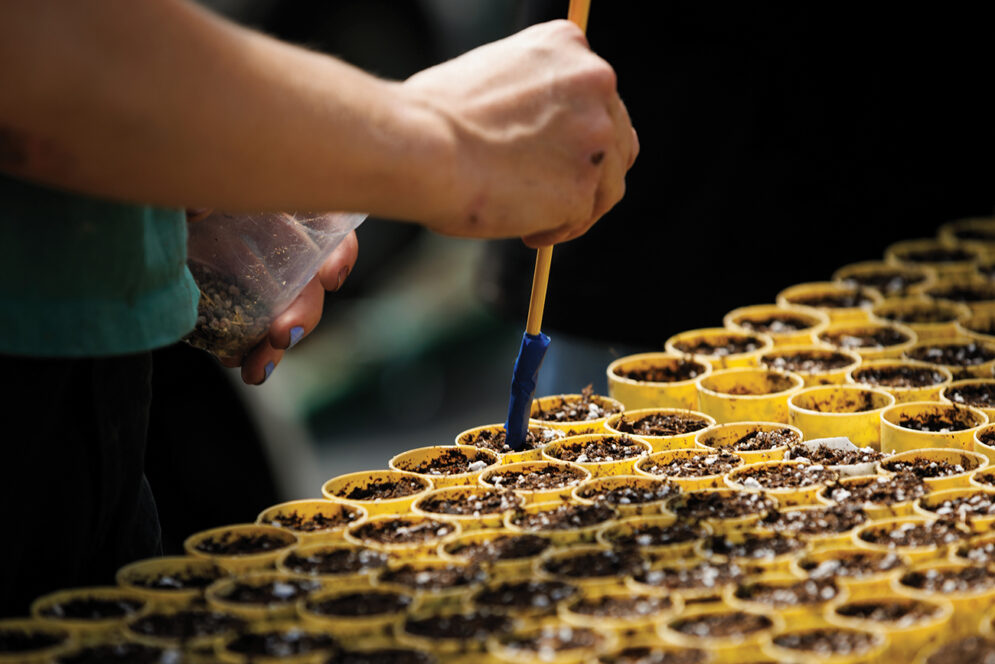
A student uses a pencil to prepare a supercell planter for lupine seeds. Supercells are conical to allow for the plant’s long taproot, which dives below the dunes to reach water.
“This is a super bountiful spot,” says Lily Patrick, a third-year environmental management and protection student, crunching over to a patch of yarrow. She gestures with her shears at a nearby flame-red bloom, identifying the plant as paintbrush. This is Patrick’s first time working on a restoration project.
“There’s leadership that’s here if you need it and encouragement from them, but also a lot of encouragement to trust yourself, because there are some things we have to figure out on our own,” she said. “Being able to come out here and take what I know from my own personal experience and my classes and do my best out here, in a really encouraging environment, is really beneficial.”
The group is tight-knit, Patrick said, and being able to work with a group of people who share a passion is inspiring.
“We all care about the environment so much. We want to see the area that we live in look its best and make sure people living here are healthy and happy. Being able to contribute to that is phenomenal,” she said. “I feel like this is an opportunity I wouldn’t get anywhere else. Being able to have that firsthand experience here is really unique, and I’m proud that Cal Poly is part of this.”
Wagner, a senior member of the State Parks team, has been coming out to the dunes since he was a Cal Poly student himself.
“There are a lot of great things about Cal Poly, especially the opportunities to get out, see professionals in the field and being able to take part — not only to observe, but to also participate,” he said. “We really appreciate having the students’ help and giving them the opportunity to have real-life experience in the field.”
For Glick, that’s one of the many benefits of the Cal Poly collaboration: training a new generation of students to be environmental stewards and serve communities around California.
“I could have gone to a private nursery and paid them to grow plants, but I don’t think it would have the same effect,” Glick said. “What we’re doing through this partnership is building experience and building the capacity of the restoration community.
“I think we all realize this is what Cal Poly is about,” Glick continued. “This is Learn by Doing on a big scale.”


